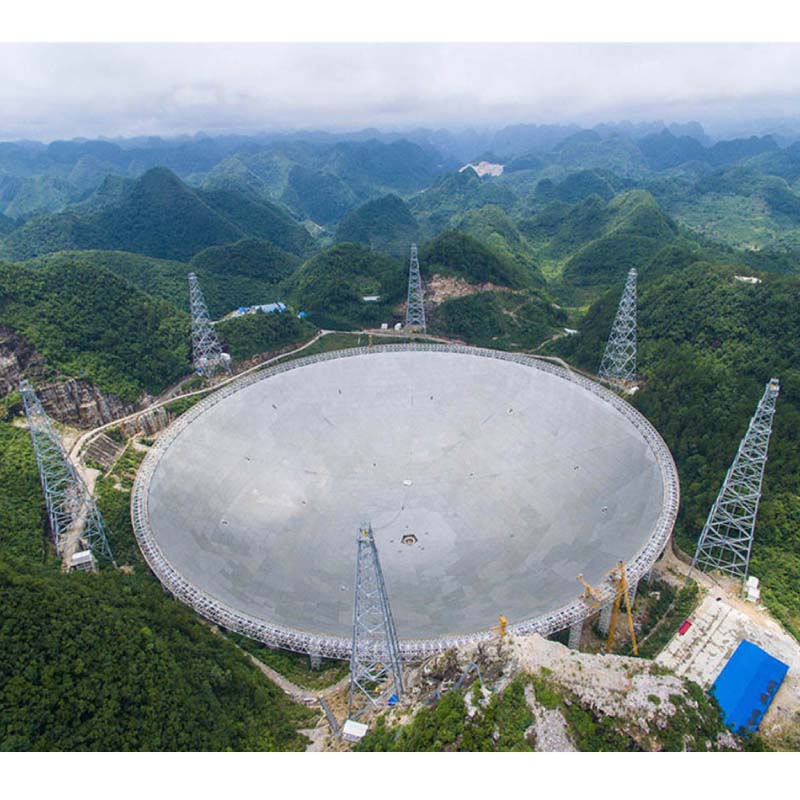
1. Hong Kong-Zhuhai-Macau Bridge. The first curved section of the underwater tunnel for the Hong Kong-Zhuhai-Macau Bridge was successfully completed last Oct. 8. Hailed as “one of the seven modern wonders in the world,” it is the world’s longest bridge currently under construction. The bridge will link Hong Kong, Macau, Zhuhai and the western part of the Pearl River Delta, one of the most economically developed areas in the Chinese mainland.
Starting from Lantau Island in Hong Kong, the Y-shaped bridge will boast a total length of about 55 kilometers, including a 6.7-kilometer underwater tunnel and a 23-kilometer bridge over the sea. Bridge construction is expected to be completed by the end of 2017; travel time between Hong Kong and Zhuhai or Macau will be reduced from three and a half hours to just 30 minutes.
2. FAST telescope. The world’s largest radio telescope, a 500-meter aperture spherical telescope, is in a mountainous region of Guizhou province. It debuted last Sept. 25. FAST was built in a hollow that formed 45 million years ago, following the collapse of a karst cave. Work on the nearly RMB1.2 billion ($180 million) project started in 2011, 17 years after it was proposed by Chinese astronomers. FAST’s tasks include the observation of pulsars as well as the exploration of interstellar molecules and interstellar communication signals. More than 8,000 people were relocated to make way for the project, which requires radio silence within a 5-km radius. Visitors to the zone must turn off their mobile phones.
3. China National Gene Bank. CNGM, located in Shenzhen, Guangdong province, officially opened last Sept. 22. It aims to promote human health research and the conservation of global biodiversity. Initiated by China’s National Development and Reform Commission in 2011, the project was established by Shenzhen-based BGI, one of the world’s leading genomics organizations. Covering an area of over 47,500 sqm, the bank is the world’s fourth national-level gene bank, following those of the US, Europe and Japan.
4. World’s largest ship lift at Three Gorges Dam. Trial operation of the permanent ship lift at the Three Gorges Dam in Hubei province began last Sept. 18. The lift, designed by a Chinese and German team, the largest and most sophisticated in the world, is designed to help small and medium-sized ships (maximum displacement of about 3,000 tons) to traverse the dam. The water level behind the dam is up to 113 meters higher than downstream. It used to take ships three to four hours to pass the dam via the ship lock; the ship lift will cut the time to between 40 minutes and an hour.
5. High-speed train passes 420 km/h speed test. China carried out a high-speed train test last July 15, during which the passing speed of two trains reached 420 km per hour. The experiment, carried out by China Railway Corporation in Zhengzhou, Henan province, set a world record.
6. Sunway-TaihuLight. China’s new supercomputing system, Sunway-TaihuLight, was named the world’s fastest computer at the International Supercomputing Conference in Germany last June 20. Performing 93 quadrillion calculations per second, Sunway TaihuLight dethroned China’s Tianhe-2 from the No. 1 spot on a list of the 500 most powerful supercomputers in the world. The National Supercomputing Center was unveiled the same day in Wuxi, Jiangsu province, where the supercomputer is installed.
7. Long March-7 carrier rocket. China successfully launched its new-generation carrier rocket Long March-7 from a new launch center in Wenchang, Hainan province last June 25. Long March-7 is a medium-sized, two-stage rocket that can carry up to 13.5 tons into low-Earth orbit. Experts predict that the 53.1-meter-long, 597-ton rocket will become the main carrier for China’s future space missions.
8. Quantum communications satellite. China successfully launched the world’s first quantum communications satellite, Quantum Experiments at Space Scale, from the Jiuquan Satellite Launch Center in the northwestern Gobi Desert in Jiuquan, Gansu province, last Aug. 16. The over 600 kg satellite will circle earth once every 90 minutes after it enters a sun-synchronous orbit at an altitude of 500 km. It was nicknamed “Micius,” after a fifth century BC Chinese philosopher and scientist credited with being the first person in human history to conduct optical experiments. During its two-year mission, QUESS is designed to establish “hack-proof” quantum communications by transmitting uncrackable keys from space to the ground, and to provide insights into the strangest phenomenon in quantum physics – quantum entanglement.
9. Space lab Tiangong-2. China achieved a successful launch of space lab Tiangong-2 from the Jiuquan Satellite Launch Center last Sept. 15. The space lab will eventually transfer to a slightly higher orbit at 393 km above earth – the same height at which the future Chinese space station will operate – before the Shenzhou-11 manned spaceship ferries two male astronauts into space to dock with the lab. The launch of Tiangong-2 will lay a solid foundation for the building and operation of a permanent space station in the future.
10. C919 big passenger plane. China’s first domestically produced large passenger aircraft C919 was unveiled in Shanghai on Nov. 2, making China one of the few countries in the world with the R&D capability to manufacture large passenger aircraft. The C919 was developed by the Commercial Aircraft Corp. of China and is expected to compete with the updated Airbus 320 and Boeing’s 737.





